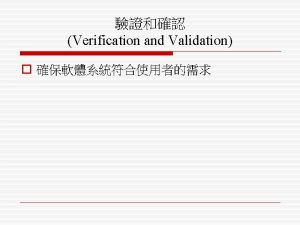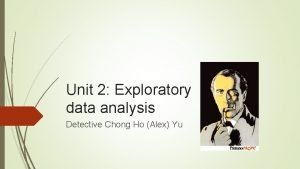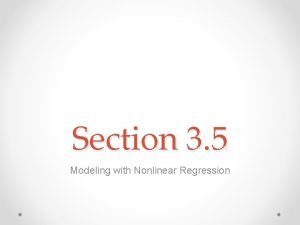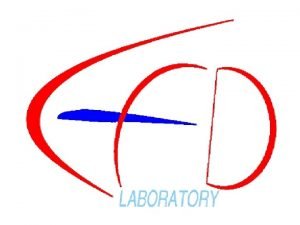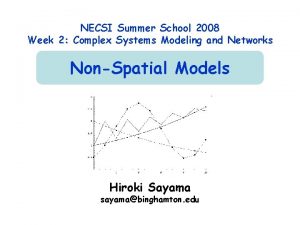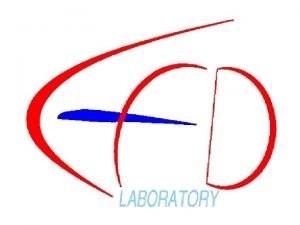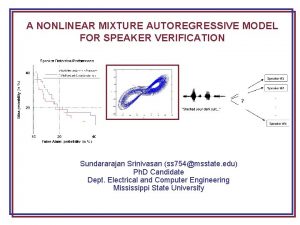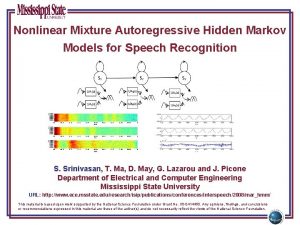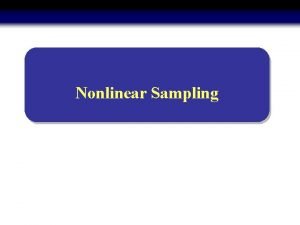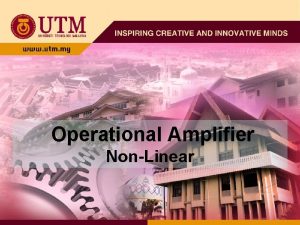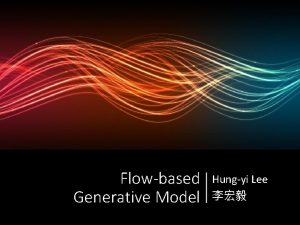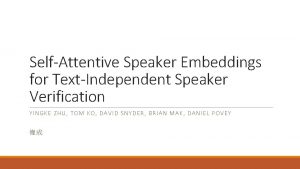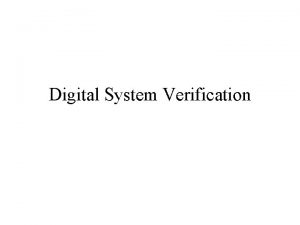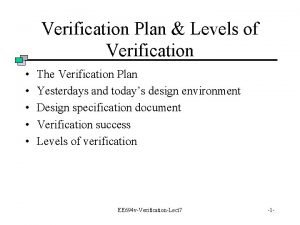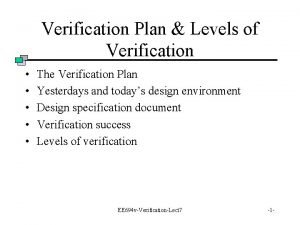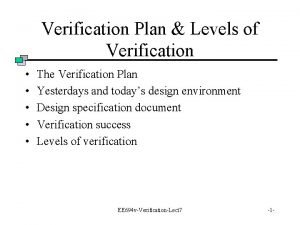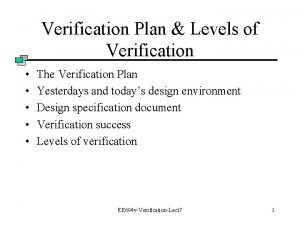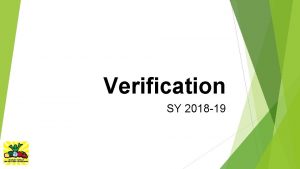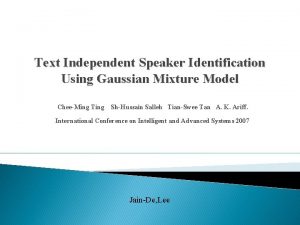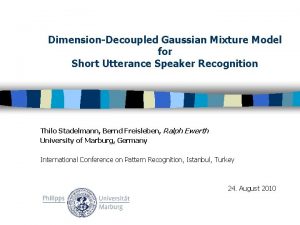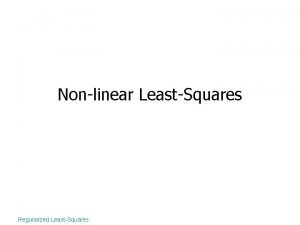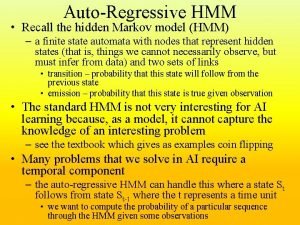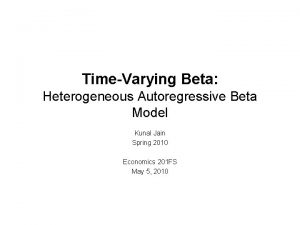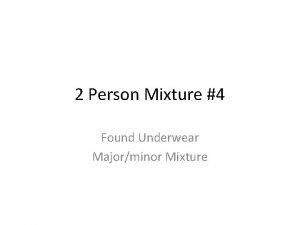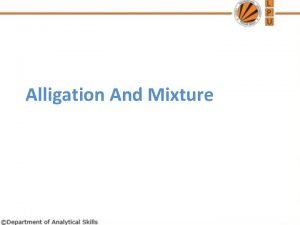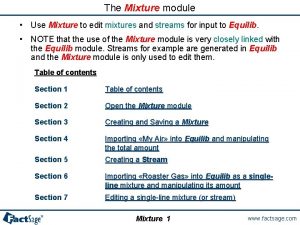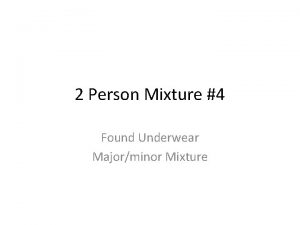A NONLINEAR MIXTURE AUTOREGRESSIVE MODEL FOR SPEAKER VERIFICATION










































- Slides: 42

A NONLINEAR MIXTURE AUTOREGRESSIVE MODEL FOR SPEAKER VERIFICATION Sundararajan Srinivasan (ss 754@msstate. edu) Department of Electrical and Computer Engineering Mississippi State University

Key Contributions • Provides motivation for representing information in the nonlinear dynamics of speech at the modeling level. • Introduces a nonlinear model - mixture autoregressive (Mix. AR) model, and proposes a technique for integrating it into a speech processing/speaker verification framework. • Derives enhancements to the Mix. AR model training equations to facilitate convergence. • Demonstrates the efficacy of the Mix. AR model for speaker verification tasks using results from experiments on a variety of databases – from controlled synthetic data to standard and popular real speech databases. • Demonstrates superiority of Mix. AR over the most popular conventional model, Gaussian Mixture Model (GMM), for speaker verification tasks over a variety of noise and channel conditions. Slide 1

Speaker Verification Overview • Speaker Recognition • Speaker Identification • Speaker Verification • Accept or Reject identity claim made by a speaker (a Binary Decision) • Applications: Secured access, surveillance, multimodal authentication. Slide 2

Speaker Verification Performance Measures • Two Kinds of Errors • False Alarms: Imposter is accepted • Misses: True speaker is rejected • A threshold value determines operating point. By varying the value of threshold, one error can be reduced at the expense of the other. • Detection Error Tradeoff (DET) Curve: Graph with false alarms on x-axis and misses on y-axis. • Model A better than Model B if DET curve of A lies consistently closer to origin that of B. • Scalar performance measures more convenient. • Equal Error Rate (EER): Point at which line with slope 1 and passing through origin intersects DET curve. • Weights false alarms and misses equally. Slide 3

Menagerie of Speakers Sheep: average good speaker Lambs: anyone can imitate a lamb’s bleat - false alarm. Slide 4 Goats: is this a human baby? No, it’s a goat! - a miss. Wolves: can pass themselves as sheep with a little cross-dressing - false alarm.

Features for Speech • Speaker Verification is a pattern classification problem. • Requires features to represent information in data from each class. • Speech Mel-Frequency Cepstral Coefficients (MFCCs) • Most popular in speech and speaker recognition applications. • Physically motivated based on auditory perception properties of the human ear. • Both absolute MFCCs as well as their dynamics are considered to be very useful in speech and speaker recognition. Slide 5

Speech MFCC Feature Extraction Slide 6

Nonlinearities in speech • Traditional speech representation and modeling approaches were restricted to linear dynamics. • Recent studies indicate significant nonlinearities are present in speech signal that could be useful in speech and speaker recognition, especially under noisy and mismatched channel conditions. • Most research striving to utilize nonlinear information in speech use nonlinear dynamic invariants as additional features. • Nonlinear Dynamic Invariants are features that are unaffected (hence, invariant) by smooth invertible transformations (diffeomorphisms) of the signal. They typically measure the degree of nonlinearity in the signal. • Three invariants we studied: -Lyapunov Exponents (LE), -Correlation Fractal Dimension (CD), -Correlation Entropy (CE). Slide 7

Nonlinear Dynamic Invariants • We demonstrated usefulness of all three invariants for broad-phone classification. • To illustrate this for one case: • Lyapunov Exponents (LE): quantify nonlinearity by capturing sensitivity to initial conditions – hallmark of chaotic nonlinear systems. where J is the Jacobian matrix at point p on the signal attractor. • How distinct is this feature for different broad-phone classes? • Kullback-Leibler Divergence Measure quantifies how different two distributions are: Larger the value, more distinct and hence separable the classes are. Slide 8

Invariants for Broad-Phone Classification KL-Divergence of LE for Broad-Phone Discriminability using Sustained Phone Database Developed In-House • Demonstrates broad-phone classification is possible using nonlinear invariants. Slide 9

Invariants for Speech Recognition • Can nonlinear invariants be used for more complicated and realistic speech processing tasks? Continuous Speech Recognition Results using AURORA-4 Large Vocabulary Speech Recognition Corpus: TABLE 3. Continuous Speech Recognition Results for Noisy Evaluation Data WER (%) Airport Babble Car Restaur Street Train ant Baseline 53. 0 55. 9 57. 3 53. 4 61. 5 66. 1 CD 57. 1 59. 1 65. 8 55. 7 66. 3 69. 6 LE 56. 8 60. 5 58. 0 66. 7 69. 0 CE 52. 8 56. 8 58. 8 52. 7 63. 1 65. 7 All 58. 6 63. 3 72. 5 60. 6 70. 8 72. 5 • Demonstrates performance degrades when nonlinear invariants are used under noisy conditions! Slide 10

Motivation for Nonlinear Modeling of Speech • For simple broad-phone classification nonlinear invariants appear to have useful information. • For complex large vocabulary speech recognition tasks under noisy conditions, the use of nonlinear invariants degrades performance. • We conjecture that the failure of nonlinear invariants for natural speech processing is because of: • Difficulty in parameter estimation from short-time segments. • Inadequacy in representing the actual nonlinear dynamics. • Capturing nonlinearities at the modeling level is desirable; this is the motivation for the rest of this work. Slide 11

Gaussian Mixture Modeling (GMM) – The Tradition • A random variable x drawn from a Gaussian Mixture Model has a probability density function defined by: • An equivalent formulation of a GMM: where is a Gaussian r. v. with mean 0 and covariance . Slide 12

GMM in speech processing systems and its limitations • GMM is the primary statistical representation for speech signals currently. • Can be easily incorporated into a Hidden Markov Model (HMM). • Found to be very successful in speech recognition but offers no improvement over GMMs in speaker recognition. • ML estimation with Expectation-Maximization algorithm is quick to converge (typically 3 -4 iterations). • In speaker recognition, each Gaussian represents a different broad phone class of sounds produced by a speaker. Since the same phoneme is pronounced differently by different speakers, the GMMs of speakers are dissimilar. • Main Drawback: It is a model for a random variable, so cannot model dynamics in feature streams. • Old Solution: Use differential MFCC features to represent dynamics; append with absolute features, and model using GMM. • Drawbacks of this solution: Differential features are only a linear approximation to the nonlinear dynamics; Redundancy is present in combined features. • Proposed Solution: Use a nonlinear model to capture the static as well as nonlinear dynamic information in speech MFCC streams. Slide 13

Mixture Autoregressive Model (Mix. AR) – A Nonlinear Model • A mixture autoregressive process (Mix. AR) of order p with m components, X={x[n]}, is defined as : Slide 14

Mix. AR in Speech Processing • Mix. AR is distinct from other autoregressive and mixture autoregressive models found in speech literature. • This is the more general than all other mixture autoregressive models found in speech literature. • ML parameter estimation can be achieved using Generalized EM algorithm • Generalized EM: At each iteration, the likelihood is not maximized, but the algorithm moves along the direction of increasing likelihood. • Probabilistic mixing of AR processes implies nonlinearity in the model. • Hope to capture both static as well as dynamics in speech signals using absolute (static) MFCCs alone. • Mix. AR in Speech Processing – what to expect? • Use only static MFCCs with Mix. ARs to perform as well as GMMs using static+differential features. • Remove feature redundancy = > Fewer parameters • Using nonlinear information in speech, Mix. AR performs better than GMM especially under noisy conditions. Slide 15

Mix. AR Model Parameter Estimation • Mix. AR model parameters • Estimated recursively using the Generalized Expectation Maximization (GEM) algorithm. • E-step where and • M-step , where , and Slide 16

Mix. AR Model Parameter Estimation • Weighting gate parameter update is only through numerical approximation (this is the reason for the name “Generalized” EM. ) and • The expression for Q-function for this EM algorithm is: • To implement the numerical approximation, I used secant method for estimating β: • Using this, the weighting gate parameter update equations are: and Slide 17

Mix. AR Model Parameter Estimation • Mix. AR GEM convergence example Slide 18

Preliminary Experiment I Two-Way Classification with Synthetic Data • Model for Class 1 data (Linear Dynamics) • Model for Class 2 data (Nonlinear Dynamics) • Classification Error Rate (%) (number of parameters in paranthesis) Mix. AR can model nonlinear dynamics using only static features and achieve better classification than GMM. Slide 19 # mix. GMM Static Mix. AR GMM Mix. AR Static+∆ 2 36. 0 (12) 6. 5 (20) 10. 0 (24) 5. 5 (40) 4 35. 5 (24) 6. 0 (40) 11. 5 (48) 4. 5 (80)

Preliminary Experiment II Two-Way Classification with Speech-Like Data • Two speakers from NIST 2001 database were chosen. For each speaker: • X 1: Data with linear dynamics generated from trained HMMs (3 states, 4 Gaussian mixtures per state). • X 2: Data with nonlinear dynamics generated from trained Mix. AR (32 mixtures). • A range of signals with varying degrees of nonlinearity generated using: α • Classification Error Rate (%) (number of parameters in paranthesis) With increasing amounts of nonlinearity, Mix. AR does significantly better than GMM Slide 20 GMM-8 mix. Mix. AR-4 Static+∆ mix. Static 0. 0* 1. 5 (288) 1. 5 (240) 0. 25 3. 25 (576) 3. 5 (240) 0. 50 10. 25 (576) 6. 25 (240) 0. 75 24. 75 (576) 9. 75 (240) 1. 0 26. 75 (576) 13. 75 (240)

Preliminary Experiment III Speaker Verification Experiments with Synthetic Data • All 60 speakers from development part of NIST 2001 SRE Corpus were used. • Clean Data • Linear Data: generated from trained HMMs (3 states, 4 Gaussian mixtures per state). • Nonlinear Data: generated from trained Mix. AR (32 -mix). • Noisy Data • Clean utterances corrupted with 5 d. B car noise audio using FANT software. • Linear and Nonlinear data generated as above. • Results • No significant difference in performance between GMM and Mix. AR if data are either linear or clean. But if data are both noisy and nonlinear a significant difference in performance was found! Slide 21

Preliminary Experiment III Speaker Verification DET with Synthetic Data • For data that is both noisy and nonlinear, Mix. AR performs significantly better. Slide 22

Speaker Verification Experiment with NIST 2001 • All 60 speakers from development part of NIST 2001 SRE Corpus were used. EER performance for different feature combinations Features GMM (16 -mix) Mix. AR (8 -mix) Static (12) 22. 1 19. 1 Static+E (13) 33. 1 41. 1 Static+Δ (24) 20. 6 20. 4 Static+Δ+ΔΔ (36) 20. 5 • Adding delta features does not help Mix. AR but helps GMM. • Mix. AR with only static features does better than GMM with static+delta features. • Adding energy feature degrades performance. Slide 23

Speaker Verification Experiment with NIST 2001 EER performance as a function of number of mixtures # mix. GMM Static+∆+∆∆ Mix. AR Static 2 23. 1 (216) 24. 1 (120) 4 21. 7 (432) 19. 2 (240) 8 20. 5 (864) 19. 1 (480) 16 20. 5 (1728) 19. 2 (960) • Mix. AR with only static features does better than GMM with static+delta features. • Mix. AR uses fewer parameters to achieve better performance than GMM. Slide 24

Speaker Verification Experiment with NIST 2001 DET curves for NIST-2001 development data • Mix. AR using fewer parameters and only static features does consistently better than GMM using more parameters and static+delta features. Slide 25

Effect of Mix. AR Order • Increasing order leads to estimation problems due to numerical approximation involved in the M-step for gate coefficients. • However, we tried increasing the order from 1 to 2 to study the effects on verification performance on NIST-2001 development database. EER performance as a function of Mix. AR order # mix. Mix. AR Order 1 Mix. AR Order 2 8 19. 1 19. 2 • Increasing Mix. AR order does not lead to improved performance (perhaps due to estimation problems). Slide 26

Speaker Verification Experiment with TIMIT • All 168 speakers in the core test set were used. • 5 utterances were used to train each speaker model and the remaining 5 for evaluation. EER performance as a function of number of mixtures # mix. GMM Static+∆+∆∆ Mix. AR Static 4 3. 6 (432) 3. 0 (240) 8 2. 4 (864) 1. 8 (480) 16 2. 4 (1728) 1. 7 (960) • Mix. AR using fewer parameters and only static features does better than GMM using more parameters and static+delta features. Slide 27

Effect of Different Speech Noise Levels and Types Speaker Verification Experiments with TIMIT under Noisy Conditions • Noise was added to TIMIT database at various SNR levels and speaker verification performance studied. GMM (1728) SNR (d. B) Car Noise Clean Mix. AR (480) Slide 28 White Babble Noise 2. 4 10 d. B 19. 7 48. 7 40. 6 5 d. B 31. 2 50. 0 44. 7 0 d. B 39. 3 49. 8 48. 2 Clean 1. 8 10 d. B 13. 7 47. 0 36. 9 5 d. B 23. 2 47. 6 42. 8 0 d. B 33. 9 48. 5 47. 6

Effect of Different Speech Noise Levels and Types Speaker Verification DET with TIMIT+White noise Slide 29

Effect of Different Speech Noise Levels and Types Speaker Verification DET with TIMIT+Babble noise Slide 30

Effect of Different Speech Noise Levels and Types Speaker Verification DET with TIMIT+Car noise Slide 31

Effect of Different Channel Conditions Speaker Verification Experiments with similar speech data but different channel conditions • TIMIT (high quality speech audio) vs. NTIMIT (telephone-quality speech audio) Database GMM (1728) Static+∆+∆∆ MFCCs Mix. AR (480) Static MFCCs Only TIMIT 2. 4 1. 8 NTIMIT 21. 0 20. 9 • Mix. AR using fewer parameters and only static features provides comparable performance to that of GMM using more parameters and static+delta features. Slide 32

Effect of Different Channel Conditions • TIMIT (high quality speech audio) vs. NTIMIT (telephone-quality speech audio) Slide 33

Effect of Training Data Duration Speaker Verification Experiments with Variable Amounts of Training Data using NIST 2001 Development Database • Important to study if Mix. AR is applicable when training data is limited. GMM (864) Mix. AR (480) Slide 34 Training Utterance Duration EER 120* 20. 5 90 20. 4 60 20. 4 30 24. 4 15 29. 5 120* 19. 2 90 21. 5 60 21. 8 30 21. 8 15 24. 3 • There is a 43. 9% increase in EER for GMM when the training utterance duration reduces from about 120 s to 15 s • The corresponding increase in EER for Mix. AR is only 26. 56%. • Mix. AR can handle shorter training data durations better than GMM. - This is perhaps due to the smaller number of parameters to be estimated for Mix. AR while GMM suffers parameter estimation problems when training data is limited.

Effect of Evaluation Data Durtation Speaker Verification Experiments with Variable Amounts of Evaluation Data using NIST-2001 development database • Does Mix. AR perform well when evaluation data is short? . GMM (864) Mix. AR (480) Slide 35 Evaluation Utterance Duration EER 30* 20. 5 15 21. 8 10 21. 5 5 24. 4 3 26. 9 30* 19. 2 15 23. 4 10 23. 1 5 25. 6 3 25. 6 • For GMM, there is an increase in EER of 31. 2% as the evaluation duration reduces from about 30 s to 3 s. • The corresponding reduction for Mix. AR is 33. 3%. • Mix. AR appears to be affected slightly more by duration than GMM as the evaluation data duration is reduced.

Summary and Conclusion • Outlined speaker verification problem and associated figures of merit. • Motivated use of nonlinear models in speech systems. • Introduced Mix. AR as a nonlinear statistical model into speaker verification systems. • Studied Mix. AR parameter estimation problem using Generalized EM algorithm. • Evaluated Mix. AR on a variety of noise and channel conditions and using several standard databases, and demonstrated superiority of Mix. AR over GMMs for speaker verification. • In almost all cases, Mix. AR used 2 x fewer parameters to achieve performance exceeding or comparable to that of GMM. • Studied training and evaluation utterance duration effects on verification performance. Slide 36

Future Scope of Mix. AR in Speech Systems • Study computational complexity of both Mix. AR and GMM, especially for the evaluation stage which needs to be performed near real-time while training is typically offline. • Extend the concept of universal background models (UBM) in GMMs to Mix. AR by deriving speaker adaptation techniques. This can help training models for speakers with very little data. • Design discriminative approaches to Mix. AR training parallel to those for GMM and note if performance of Mix. AR is improved. • Extend the applicability of Mix. AR to other speech processing problems – particularly speech recognition. This is perhaps the most important, though also, difficult step in establishing Mix. AR as a superior alternative to GMM. Slide 37

Brief Bibliography • X. Huang, A. Acero, and H. Hon, Spoken Language Processing: A Guide to Theory, Algorithm, and System Development, Prentice-Hall, 2001. • D. A. Reynolds, and W. M. Campbell, “Text-Independent Speaker Recognition, ” pp. 763– 781, book chapter in: Y. H. J. Benesty (editor), Handbook of Speech Processing, Springer, Berlin, Germany, 2008. • D. May, Nonlinear Dynamic Invariants For Continuous Speech Recognition, M. S. Thesis, Department of Electrical and Computer Engineering, Mississippi State University, USA, May 2008. • S. Prasad, S. Srinivasan, M. Pannuri, G. Lazarou and J. Picone, “Nonlinear Dynamical Invariants for Speech Recognition, ” Proceedings of the International Conference on Spoken Language Processing, pp. 2518 -2521, Pittsburgh, Pennsylvania, USA, September 2006. • M. Zeevi, R. Meir, and R. Adler, “Nonlinear Models for Time Series using Mixtures of Autoregressive Models”, Technical Report, Technion University, Israel, available online at: http: //ie. technion. ac. il/~radler/mixar. pdf, October 2000. • C. S. Wong, and W. K. Li, “On a Mixture Autoregressive Model, ” Journal of the Royal Statistical Society, vol. 62, no. 1, pp. 95‑ 115, February 2000. • S. Srinivasan, T. Ma, D. May, G. Lazarou and J. Picone, "Nonlinear Mixture Autoregressive Hidden Markov Models for Speech Recognition, " Proceedings of the International Conference on Spoken Language Processing, pp. 960 -963, Brisbane, Australia, September 2008. Slide 38

Available Resources Speech Recognition Toolkit: Institute for Signal and Information Processing (ISIP) Speech Recognition System Slide 39

Publications • S. Srinivasan, T. Ma, D. May, G. Lazarou and J. Picone, "Nonlinear Statistical Modeling of Speech, " presentated at the 29 th International Workshop on Bayesian Inference and Maximum Entropy Methods in Science and Engineering (Max. Ent), Oxford, Mississippi, USA, July 2009. • S. Srinivasan, T. Ma, D. May, G. Lazarou and J. Picone, "Nonlinear Mixture Autoregressive Hidden Markov Models for Speech Recognition, " Proceedings of the International Conference on Spoken Language Processing (Interspeech), pp. 960 -963, Brisbane, Australia, September 2008. • S. Prasad, S. Srinivasan, M. Pannuri, G. Lazarou and J. Picone, “Nonlinear Dynamical Invariants for Speech Recognition, ” Proceedings of the International Conference on Spoken Language Processing (Interspeech), pp. 2518 -2521, Pittsburgh, Pennsylvania, USA, September 2006. • Sundararajan Srinivasan, Bhiksha Raj and Tony Ezzat, "Ultrasonic Sensing for Robust Speech Recognition, " Proceedings of the International Conference on Acoustics, Speech and Signal Processing (ICASSP), SP-P 14. 5, Dallas, USA, March, 2010. To be Submitted • S. Srinivasan, T. Ma, G. Lazarou and J. Picone, “Nonlinear Mixture Autoregressive Modeling for Robust Speaker Verification, ” IEEE Transactions on Audio, Speech and Language Processing (submitted November, 2010). • T. Ma, S. Srinivasan, G. Lazarou and J. Picone, “Continuous Speech Recognition using Linear Dynamic Models, ” IEEE Signal Processing Letters (to be submitted November, 2010). Slide 40

Thank You! Questions? Slide 41
 Is windex homogeneous or heterogeneous
Is windex homogeneous or heterogeneous V model verification and validation
V model verification and validation Nonlinear model
Nonlinear model Nonlinear regression exponential model
Nonlinear regression exponential model Non linear model
Non linear model Nonlinear model
Nonlinear model Nonlinear model
Nonlinear model Iso 22301 utbildning
Iso 22301 utbildning Typiska novell drag
Typiska novell drag Nationell inriktning för artificiell intelligens
Nationell inriktning för artificiell intelligens Vad står k.r.å.k.a.n för
Vad står k.r.å.k.a.n för Varför kallas perioden 1918-1939 för mellankrigstiden?
Varför kallas perioden 1918-1939 för mellankrigstiden? En lathund för arbete med kontinuitetshantering
En lathund för arbete med kontinuitetshantering Adressändring ideell förening
Adressändring ideell förening Tidbok yrkesförare
Tidbok yrkesförare A gastrica
A gastrica Densitet vatten
Densitet vatten Datorkunskap för nybörjare
Datorkunskap för nybörjare Stig kerman
Stig kerman Debatt artikel mall
Debatt artikel mall Delegerande ledarstil
Delegerande ledarstil Nyckelkompetenser för livslångt lärande
Nyckelkompetenser för livslångt lärande Påbyggnader för flakfordon
Påbyggnader för flakfordon Formel för lufttryck
Formel för lufttryck Svenskt ramverk för digital samverkan
Svenskt ramverk för digital samverkan Urban torhamn
Urban torhamn Presentera för publik crossboss
Presentera för publik crossboss Teckenspråk minoritetsspråk argument
Teckenspråk minoritetsspråk argument Bat mitza
Bat mitza Treserva lathund
Treserva lathund Epiteltyper
Epiteltyper Bästa kameran för astrofoto
Bästa kameran för astrofoto Cks
Cks Programskede byggprocessen
Programskede byggprocessen Mat för unga idrottare
Mat för unga idrottare Verktyg för automatisering av utbetalningar
Verktyg för automatisering av utbetalningar Rutin för avvikelsehantering
Rutin för avvikelsehantering Smärtskolan kunskap för livet
Smärtskolan kunskap för livet Ministerstyre för och nackdelar
Ministerstyre för och nackdelar Tack för att ni har lyssnat
Tack för att ni har lyssnat Referatmarkeringar
Referatmarkeringar Redogör för vad psykologi är
Redogör för vad psykologi är Borstål, egenskaper
Borstål, egenskaper

